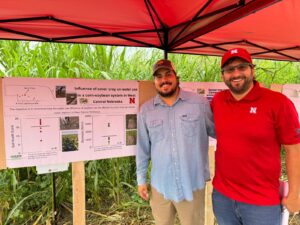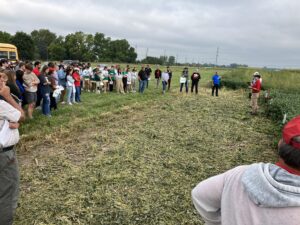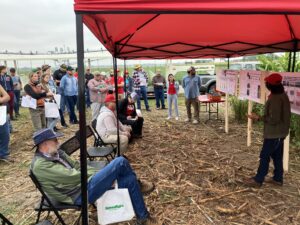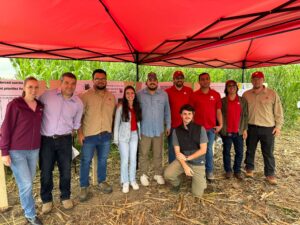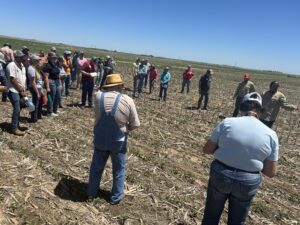Progress report for LNC23-484
Project Information
Water use for agricultural purposes is limited in West Central Nebraska due to low annual rainfall (16-22 inches), areas with irrigation water allocations, and areas with sandy soils. Therefore, water savings are economically and environmentally relevant for farmers and the sustainability of the natural resources in the region. Besides the well-documented overall benefits of cover crops in other regions, their adoption in the West Central Region in dryland is rare and low in irrigated systems due to the concern of excessive water use by the cover crop that will compromise the following cash crop. These concerns are documented in previous small plot-type research while looking at different cover crop termination times. However, there is no mid to long-term research in West Central Nebraska on whether these one-year adverse effects of cover crops can be overcome in the mid or long-term by continuously using cover crops. A combination of experiments at research stations is proposed, comparing the use of continuous cover crops vs. no cover crops under different irrigation levels, and involving farmers through on-farm research trials. Soil moisture will be tracked with neutron probe and watermarks. We will also quantify the cash crop yield and cover crop biomass produced, and compare the results with those from the no-cover crop plots. Outcomes from this project are expected to provide guidelines on how much irrigation water can be saved when continuously using cover crops or how much cash crop yield can be gained by increasing soil water availability with cover crops in dryland, irrigated, and limited irrigation cropping systems of West Central Nebraska.
This project aims to research the water use of continuous cover crops and cash crops in irrigated and dryland cropping systems in West Central Nebraska.
Specifically:
_Quantify how many inches of water can be saved by the continuous use of cover crops in irrigated cropping systems in West Central Nebraska.
_Determine whether there is a rainfall or irrigation threshold at which cover crops' benefits disappear.
_Establish mid- to long-term areas that use continuous cover crops as a showcase.
_Recruit six farmers with a 3-year commitment for on-farm research and provide cover crop seed and guidelines to test cover crop water use in West Central Nebraska.
_Develop a cover crops clinic for irrigated and dryland cropping systems in West Central Nebraska for crop consultants and farmers.
Water use for agricultural purposes is limited in West Central Nebraska due to low annual rainfall (16-22 inches), areas with irrigation water allocations, and areas with sandy soils. Therefore, any possibility of water saving is economically and environmentally relevant for farmers and the sustainability of the natural resources in the region. Several of Nebraska’s Natural Resource Districts in West Central Nebraska are under irrigation water allocations that are being reduced due to concerns about the aquifer level. Besides the well-documented overall benefits of cover crops in other regions (Basche et al., 2016), their adoption in West Central Nebraska in dryland is rare and low in irrigated systems due to the concern of excessive water use by the cover crop that will compromise the following cash crop. These concerns have been documented in previous plot research (one year in a different spot) while looking at different cover crop termination times (Rosa et al., 2021 a & b). However, there is no mid to long-term research in West Central Nebraska on whether these one-year adverse effects of cover crops can be overcome in the mid or long-term by continuously using cover crops in the cropping system. Previous SARE projects in the West Central Nebraska area, or close by, that have partially looked at cover crop water use have done it at rainfall levels larger than 20 inches per year or have not attempted to measure volumetric water use and only measured biomass or yield (FNC07-653; GNC18-271; FNC14-963). During field days, crop production clinics, and other Extension events, West Central Nebraska farmers, crop consultants, and local farmers-driven institutions expressed interest in cover crops and concerns about guidelines for the area regarding water use. While other current projects in the West Central Nebraska area aim to test different cover crop' species' suitability and nitrogen use by crop and cover crop in irrigated cropland, the study of cover crop water use is lacking, and it is of high priority for cover crop adoption in the area.
This project researches the water use of continuous cover crops and cash crops in irrigated and dryland cropping systems in West central Nebraska.
Cooperators
- - Technical Advisor
- - Technical Advisor
- - Technical Advisor
- - Technical Advisor
- - Technical Advisor
Research
Hypothesis #1: The water used by the cover crop is compensated for by the improvements in the soil's ability to capture and hold water due to continuous use of the cover crop.
Hypothesis #2: Cover crop biomass production drives the benefits of cover crops on water use.
We conducted cover crop trials planted after the soybean or corn harvest in four irrigated research station fields located near Grant, NE, North Platte, NE, Gothenburg, NE, and Brule, NE. We used rye as a cover crop except for Gothenburg, where we tested other cover crop types. A randomized block design was used, with plots under center-irrigation pivots that had a variable rate irrigation capability and variable speed. To be specific, treatments were blocked based on five irrigation levels for Brule and Grant and three levels in North Platte, which included: 0%I (rainfed), 25% I(deficit irrigation and 25% of crop water requirement (ETc)), 50% I (deficit irrigation and 50% of ETc), 75% I (deficit irrigation and 75% of ETc), and 100% I (full irrigation). In Gothenburg, we only had full irrigation treatment. Cover crop and cash crop biomass and yield are being collected per replicate. A neutron probe is being used to track soil water content in all treatments.
Soil Water Measurements
Soil water is measured as volumetric water content using two well-calibrated Neutron Soil Moisture Meters (NMMs) – CPN 503 and CPN 503 DR (InstroTek, Concord, California, USA). A local gravimetric calibration has already been conducted for both NMMs and a good line-fit was produced with a coefficient of determination (R2) of 0.99 and root mean square error (RMSE) of 0.010 m3 m-3 (Lo et al., 2020) The soil moisture readings are taken every week during the cash crop season using aluminum access tubes. The readings are taken from 6 inches to 64 inches below the soil surface, at intervals of 12 inches. To find the total available soil water content or how much has been depleted within the active root zone, the field capacity of the soil, the thickness of the soil layer, and observed soil moisture (i.e., neutron readings) will be used (Katimbo et al., 2022).
Finally, we expect to develop relationships between water use and cover crop biomass, cover crop biomass and crop yield, soil water at planting and crop yield, and others. These relationships can include the pooled data from all the proposed experiments.
1. Katimbo, A., Rudnick, D.R., DeJongee, K.C., Lo, T.H., Qiao, X., Franz, T.E., Nakabuye, H.N., Duan, J., 2022. Crop water stress index computation approaches and their sensitivity to soil water dynamics. Agricultural Water Management. 266, 107575 https://doi.org/10.1016/j.agwat.2022.107575
2. Lo, T.H., Rudnick, D.R., DeJonge, K.C., Bai, G., Nakabuye, H.N., Katimbo, A., Ge, Y., Franz, T.E., Qiao, X., Heeren, D.M., 2020. Differences in soil water changes and canopy temperature under varying water× nitrogen sufficiency for maize. Irrigation Science. 8 (5), 519–534. https://doi.org/10.1007/s00271-020-00683-2
Preliminary data results of cash crop yields, cover crop biomass, cash crop biomass, and soil volumetric water content (1st-Year-SARE-Report2) All this information is being processed and will be pulled together with the second and third year of data collection to calculate water use efficiency on cover croped areas vs no cover croped areas under different levels of water supply. Results interpretation will consider the time of continuous cover cropping, the biomass of cover crop produced, and the variability across environments (sites in west central Nebraska)
Education
Farmers cooperators conduct on-farm research trials on their fields. We provide them with seed and basic cover crops guidelines, and we design together the on-farm experiments based on farmers' interests and farming operation context. Participants select a cover crop type and management, and they commit to using cover crops continuously in the same area. We install watermark sensors to track soil water content between cover crop and non-cover crop areas.
Additionally, we share preliminary results at field days and other Extension events, and show the experiments at the station at different times during tours and events. Sharing results and tours is coupled with time for peer-to-peer learning by sharing experiences, and discussion on the benefits and issues of adopting cover crops in water-limited environments.
Project Activities
Educational & Outreach Activities
Participation Summary:
There were six on-farm research demonstrations from farmers' collaborators. Also, the two main field days were in North Platte and at Grant, NE. These field days, combined with discussions on soil health, other crops, and water, were the main stops in our showcase plots. We led a cover crop panel at the Crops and Water Field Day.
As a result of these activities, we have had several consultations on topics that have been repeated, including the use of cover crops in cropping systems, the utilization of winter peas as a double-purpose crop, and livestock integration in dryland cropping systems, among others.
Learning Outcomes
- cover crop
Project Outcomes
Cover crop
